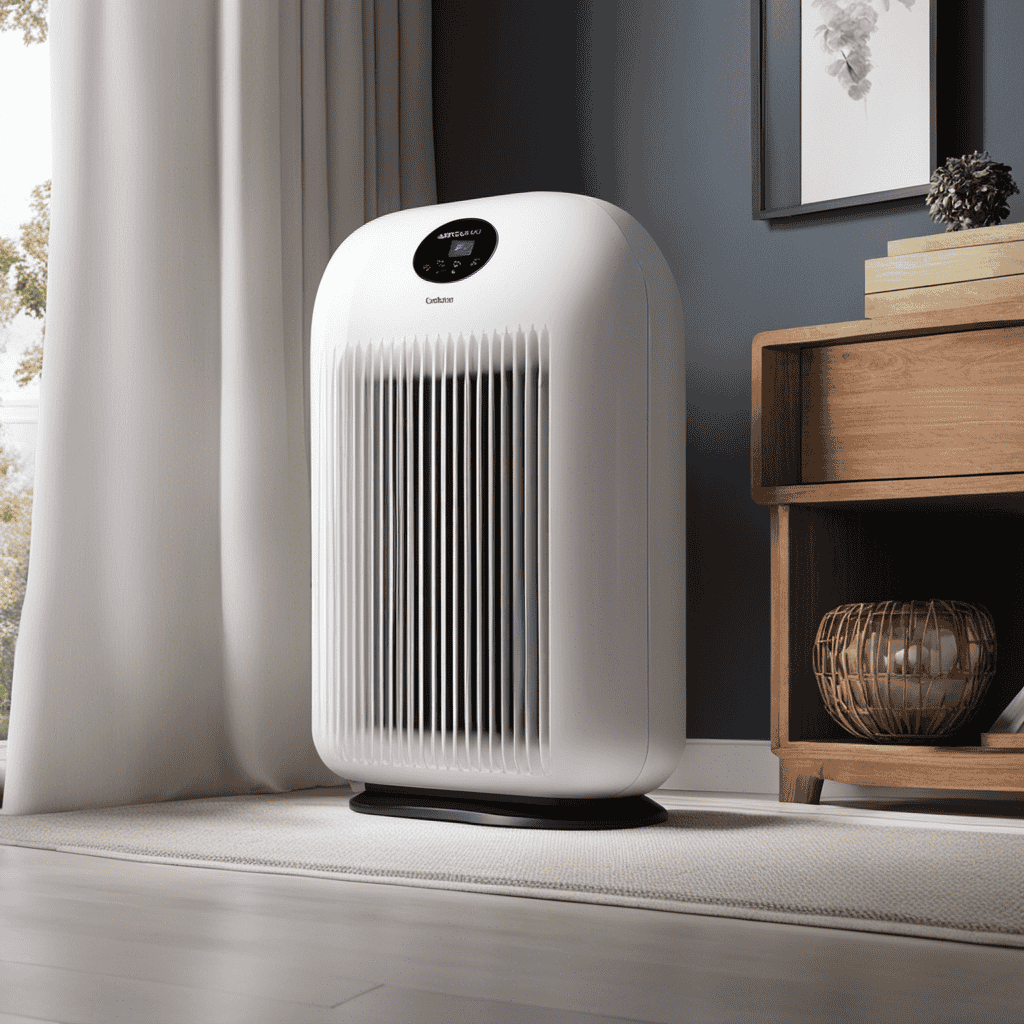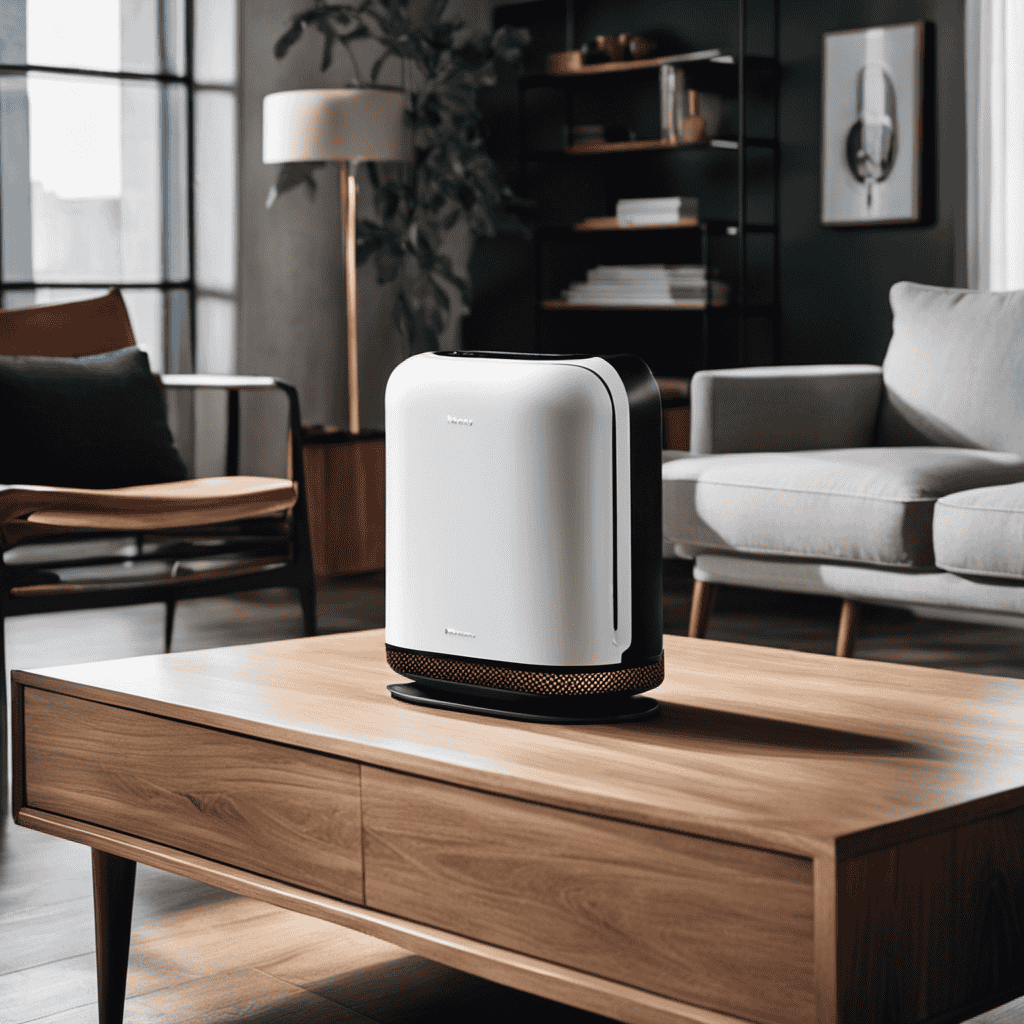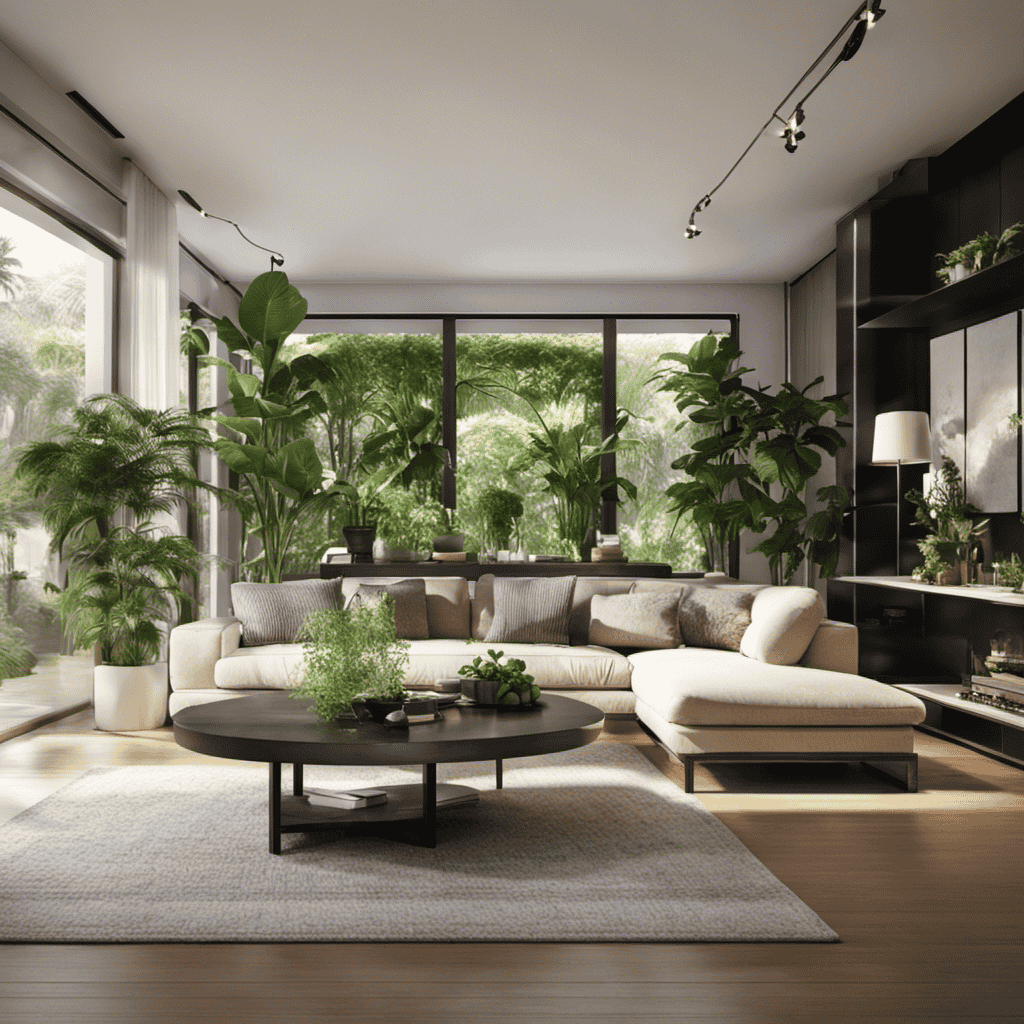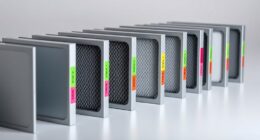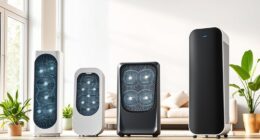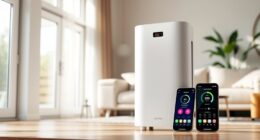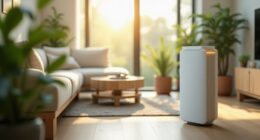As someone who is passionate about air quality, I have often pondered, “How frequently should I replace my air purifier filter?” It’s a common question that many of us have asked, and the answer isn’t always straightforward.
In this article, we will explore the factors that affect the lifespan of air purifier filters, the recommended frequency for replacement, and the signs that indicate it’s time for a change.
We’ll also discuss how to extend the lifespan of your filter and the importance of regular maintenance.
So, let’s dive in and find out the truth about air purifier filter replacement!
Key Takeaways
- Factors such as air quality, usage time, filter type, regular cleaning, and using pre-filters all affect the lifespan of an air purifier filter.
- It is important to understand the factors affecting replacement frequency and follow the manufacturer’s recommendations for filter replacement.
- Signs that indicate the need for a filter change include reduced airflow, increased dust in the home, regular cleaning and maintenance, and issues with the pre-filter or a worn-out or damaged filter.
- To extend the lifespan of an air purifier filter, regular cleaning and maintenance should be implemented, proper filter replacement strategies should be followed, and optimal air purifier function should be maintained to avoid decreased performance and potential health risks.
Factors That Affect Air Purifier Filter Lifespan
Factors like air quality, usage time, and filter type can affect how long your air purifier filter lasts. It’s important to consider these factors to determine the optimal replacement frequency and find ways to extend the filter lifespan.
Air quality plays a crucial role in filter longevity. If you live in an area with high levels of pollution or have pets that shed fur or dander, your filter may get clogged more quickly. Additionally, if you smoke indoors, the filter will need to work harder to remove the smoke particles, reducing its lifespan.
The usage time of your air purifier also affects the filter’s lifespan. The more hours it operates, the more particles it filters out, leading to faster clogging. If you run your air purifier continuously or for extended periods, you may need to replace the filter more frequently.
The type of filter you use is another crucial factor. Different filters have different lifespans. HEPA filters, for example, typically last between six months to a year, while activated carbon filters may need replacement every three to six months.
To extend your air purifier filter’s lifespan, you can take certain measures. Regularly cleaning and vacuuming your home can reduce the amount of dust and debris that enters your air purifier, thus reducing the load on the filter. Additionally, using pre-filters can help capture larger particles, preventing them from reaching the main filter and prolonging its lifespan.
Recommended Frequency for Air Purifier Filter Replacement
When it comes to optimal filter replacement for air purifiers, there are several key points to consider.
First, understanding the factors that affect replacement frequency is crucial in maintaining clean and healthy indoor air.
Second, regular filter replacement offers numerous benefits, such as improved air quality, increased efficiency, and extended lifespan of the air purifier itself.
Lastly, by following recommended guidelines for filter replacement, individuals can ensure that their air purifiers are operating at their full potential and providing the cleanest air possible.
Optimal Filter Replacement
The best time to change your air purifier filter is when it’s reached its optimal usage period. Regular filter maintenance is crucial for the longevity of your air purifier and to ensure its effectiveness in removing pollutants from the air.
Here are some important points to consider regarding optimal filter replacement:
-
Check the manufacturer’s recommendations: Different air purifiers have different filter lifespans, so it’s essential to refer to the manufacturer’s instructions for the specific model you own.
-
Monitor air quality: Keep an eye on the air quality in your home. If you notice an increase in dust, allergens, or odors, it may be a sign that your filter needs to be replaced.
-
Visual inspection: Periodically inspect your filter for any visible signs of wear and tear, such as discoloration or damage. If you notice any issues, it’s time for a replacement.
Factors Affecting Replacement
If you’ve noticed a decline in air quality, it’s likely time for a filter replacement in your air purifier. Several factors can affect the performance of your air purifier’s filter, ultimately impacting the indoor air quality of your home or office.
One important factor is the type of pollutants present in your environment. If you live in an area with high levels of outdoor pollutants, such as pollen or smog, your filter may need replacement more frequently.
Additionally, the size of your living space plays a role. A larger space will require a larger air purifier, which may have a larger filter that needs replacement more often.
Finally, the frequency of use and the level of pollutants in the air will also affect how often you need to change the filter.
To ensure optimal performance and maintain clean indoor air, it’s essential to consider these factors when determining when to replace your air purifier’s filter.
Benefits of Regular Replacement?
Regularly replacing the filter in your air purifier can greatly improve the indoor air quality of your home or office. Here are three reasons why regular replacement is beneficial:
-
Extended filter lifespan: When you replace the filter regularly, it prevents it from becoming clogged with dust, pollen, and other particles. This allows the filter to function optimally and last longer, saving you money in the long run.
-
Improved air flow: A dirty filter can restrict the airflow of your air purifier, reducing its efficiency in removing airborne contaminants. By regularly replacing the filter, you ensure that clean air can flow freely through the purifier, maximizing its effectiveness.
-
Reduced health risks: Dirty filters can harbor bacteria, mold, and other harmful microorganisms, which can be released back into the air. Regular replacement helps prevent the accumulation of these contaminants, reducing the risk of respiratory issues and allergies.
Signs That Indicate Your Air Purifier Filter Needs Changing
You’ll know it’s time to change your air purifier filter when you notice reduced airflow and increased dust in your home. These are clear signs that your filter is no longer effectively capturing and trapping airborne particles.
However, there are certain steps you can take to prolong the life of your air purifier filter and troubleshoot any issues that may arise.
To prolong the life of your air purifier filter, it is important to regularly clean and maintain it. This can be done by vacuuming the filter or gently tapping it to remove excess dirt and debris. Additionally, placing your air purifier in a location with good air circulation can help prevent the filter from getting clogged too quickly.
If you are experiencing reduced airflow or increased dust despite regular cleaning, there may be some issues with your filter. One common issue is a dirty pre-filter. The pre-filter is designed to capture larger particles and protect the main filter. Cleaning or replacing the pre-filter can help improve the performance of your air purifier.
Another potential issue is a worn-out or damaged filter. Over time, the filter may become less effective or develop tears or holes. In such cases, it is necessary to replace the filter entirely to ensure optimal air purification.
How to Extend the Lifespan of Your Air Purifier Filter
When it comes to extending the lifespan of my air purifier filter, I have found that proper maintenance techniques are key.
Regularly cleaning the filter using effective methods ensures that it continues to function optimally.
Additionally, implementing filter replacement strategies at the appropriate intervals helps to maintain the filter’s efficiency and effectiveness in purifying the air.
Proper Maintenance Techniques
To ensure your air purifier functions optimally, it’s important to regularly clean and replace the filter. Neglecting filter maintenance can lead to decreased air purifier performance and even potential health risks. Here are some proper maintenance techniques to keep in mind:
-
Clean the filter regularly: Dust and debris can accumulate on the filter, reducing its effectiveness. Vacuum or wash the filter according to the manufacturer’s instructions to remove any buildup.
-
Replace the filter as recommended: Different air purifiers have different filter lifespans, typically ranging from three to six months. Follow the manufacturer’s guidelines for replacing the filter to ensure optimal performance.
-
Troubleshoot common filter issues: If you notice a decrease in air purifier efficiency or strange odors coming from the unit, it may indicate a filter problem. Check for any visible damage or clogs and replace the filter if necessary.
Proper maintenance techniques not only improve the air quality in your home but also prolong the lifespan of your air purifier. While filter replacements may incur some cost, it’s a small price to pay for clean and healthy air.
Effective Cleaning Methods
For best results, regularly cleaning your air purifier is essential to maintain its effectiveness and ensure clean air in your home. Proper air purifier maintenance includes regular cleaning to remove dust, dirt, and other particles that can accumulate on the filters and decrease their efficiency.
The cleaning frequency depends on several factors such as the manufacturer’s recommendations, the air quality in your home, and the usage of the air purifier. In general, it is recommended to clean the pre-filter every 1-2 months and replace it every 3-6 months. The HEPA filter, which is responsible for removing smaller particles, should be replaced every 6-12 months. However, it is important to check the manufacturer’s guidelines for specific instructions as these can vary depending on the model and brand of your air purifier.
Regular cleaning and filter replacement will ensure that your air purifier continues to provide clean and fresh air for you and your family.
Filter Replacement Strategies
To ensure that your air purifier is providing optimal performance, regularly replacing the filters is crucial. There are several factors to consider when determining how often you should change your air purifier filter. These include the type of filter, the air quality in your home, and the manufacturer’s recommendations.
When it comes to cost-effective options for filter replacement, there are a few strategies you can follow.
-
Look for filters that have a longer lifespan. Some filters are designed to last up to six months or even a year, which can help save you money in the long run.
-
Consider purchasing reusable filters. These filters can be washed and reused multiple times, making them a more sustainable and cost-effective option.
-
Compare prices and shop around. Different brands and retailers may offer filters at different prices, so it’s worth doing some research to find the best deal.
Understanding the Importance of Regular Air Purifier Filter Maintenance
Understanding the importance of regular air purifier filter maintenance helps you ensure clean and healthy indoor air quality. Proper maintenance of your air purifier filter is essential to maintain its efficiency and effectiveness in removing pollutants from the air. Here are some air purifier filter maintenance tips to keep in mind.
Firstly, it is important to regularly check and clean your air purifier filter. Over time, the filter can become clogged with dust, pet dander, and other particles, reducing its ability to filter the air effectively. Signs of a clogged air purifier filter include decreased airflow, increased noise levels, and a noticeable decrease in the air quality.
To clean your air purifier filter, start by turning off the unit and unplugging it from the power source. Remove the filter according to the manufacturer’s instructions. Gently vacuum the filter or rinse it under running water to remove any trapped particles. Allow the filter to dry completely before reinstalling it.
It is recommended to replace your air purifier filter every 6 to 12 months, depending on the manufacturer’s guidelines and the air quality in your home. Regularly replacing the filter ensures that it continues to effectively capture pollutants and maintain clean air quality in your indoor environment.
Now that you understand the importance of regular air purifier filter maintenance, let’s explore the different types of air purifier filters and their lifespan.
Different Types of Air Purifier Filters and Their Lifespan
Now that we’ve covered the importance of regular air purifier filter maintenance, let’s take a look at the different types of air purifier filters and how long they typically last.
When it comes to air purifier filter types, there are a few common options available on the market:
-
HEPA Filters: HEPA (High Efficiency Particulate Air) filters are known for their ability to capture small particles as small as 0.3 microns. These filters are highly effective in removing allergens, dust, pollen, and pet dander from the air. On average, HEPA filters can last anywhere from 6 to 12 months, depending on the level of air pollution in your environment.
-
Carbon Filters: Carbon filters are excellent for removing odors, gases, and volatile organic compounds (VOCs) from the air. These filters contain activated carbon, which has a large surface area that can absorb and trap these pollutants. Carbon filters typically last around 6 months before they need to be replaced.
-
Pre-Filters: Pre-filters are the first line of defense in an air purifier. They capture larger particles such as hair, pet fur, and dust before they reach the main filter. Pre-filters are washable and generally need to be cleaned every 2 to 3 months.
Now that we know about the different types of air purifier filters and their typical lifespans, let’s move on to the next section where we will discuss common mistakes to avoid when changing air purifier filters.
Common Mistakes to Avoid When Changing Air Purifier Filters
When replacing your air purifier filter, it’s important to avoid these common mistakes. Making errors during the filter replacement process can lead to reduced performance and a shorter lifespan for your air purifier. Here are some tips to help you avoid these mistakes and prolong the lifespan of your air purifier filter:
| Mistake | Tip |
|---|---|
| Not following the manufacturer’s instructions | Always read and follow the instructions carefully |
| Neglecting regular filter replacement | Replace your filter according to the recommended schedule |
| Using the wrong type of filter | Ensure you choose the correct filter for your specific air purifier model |
By avoiding these mistakes, you can ensure that your air purifier functions optimally and effectively removes pollutants from your indoor air. Regularly replacing the filter will maintain its efficiency and prolong its lifespan. Additionally, using the correct filter will ensure that it effectively captures the specific contaminants that you want to eliminate.
Transition: Now that we know the common mistakes to avoid when changing air purifier filters, let’s explore some expert tips for choosing the right replacement air purifier filter.
Expert Tips for Choosing the Right Replacement Air Purifier Filter
To ensure optimal performance, it’s crucial to select the correct replacement filter for your specific air purifier model. With so many replacement filter options available in the market, it can be overwhelming to choose the right one. However, by considering a few key factors, you can make an informed decision and ensure that you are choosing the right filter size for your air purifier.
Here are three expert tips for choosing the right replacement air purifier filter:
-
Check your air purifier’s user manual: The user manual of your air purifier will provide you with valuable information regarding the compatible replacement filters for your specific model. It will specify the filter size and type that you should look for when purchasing a replacement.
-
Consider your specific needs: Different air purifiers are designed to address various air quality concerns. Whether you have allergies, asthma, or want to eliminate odors, make sure to choose a replacement filter that is designed to target your specific needs. Look for filters that are labeled as HEPA (High-Efficiency Particulate Air) for effective removal of airborne particles.
-
Research and compare: Before making a purchase, do some research and compare different replacement filter options. Read reviews, check the ratings, and consider the longevity of the filter. It’s also important to compare prices to ensure you are getting the best value for your money.
What is the Recommended Frequency for Changing an Air Purifier Filter?
The recommended air purifier filter replacement frequency varies depending on the manufacturer and model. However, it is generally suggested to replace the filter every 6 to 12 months to maintain optimal air quality in your home or workplace. Regular filter changes help ensure the efficient functioning of your air purifier.
Frequently Asked Questions
Can I Clean and Reuse My Air Purifier Filter Instead of Replacing It?
Yes, you can wash and reuse your air purifier filter instead of replacing it. However, it’s important to note that not all filters can be cleaned. If your filter is washable, you should clean it regularly to maintain its effectiveness. The frequency of cleaning will depend on various factors such as the manufacturer’s recommendations, the air quality in your area, and the usage of your air purifier. It’s generally recommended to clean your filter every 3-6 months, but always refer to the specific instructions provided by the manufacturer.
What Are Some Common Signs of a Faulty Air Purifier Filter?
When it comes to properly maintaining an air purifier filter, it’s essential to be aware of the signs of a faulty filter. A clogged or dirty filter can decrease the efficiency of your air purifier and compromise the quality of the air in your home.
Some common signs of a faulty filter include reduced airflow, unpleasant odors, and increased allergies or respiratory issues. Regularly changing your air purifier filter not only ensures optimal performance but also provides the benefits of cleaner air and improved health.
Is It Necessary to Use the Same Brand of Replacement Filter Recommended by the Manufacturer?
Using generic replacement filters instead of the recommended brand is a common alternative to manufacturer-recommended air purifier filters. Many generic filters are designed to be compatible with a wide range of air purifier models, providing comparable performance at a lower cost.
However, it is important to ensure that the generic filter meets the specifications and standards required for effective air purification. Reading customer reviews and checking for certifications can help in choosing a reliable generic replacement filter.
What Are the Potential Health Risks Associated With Using an Air Purifier With a Dirty Filter?
Using an air purifier with a dirty filter can pose potential health risks. When the filter becomes clogged with dirt, dust, and other pollutants, it can no longer effectively remove these particles from the air.
As a result, these contaminants can circulate back into your indoor environment, leading to respiratory issues, allergies, and other health problems.
Regularly changing your air purifier filter is essential to ensure it continues to function properly and maintain a clean and healthy indoor environment.
Are There Any Specific Cleaning Products or Techniques That Should Be Used When Maintaining an Air Purifier Filter?
When it comes to maintaining my air purifier filter, I’ve found that using alternative cleaning methods and natural cleaning products can be effective.
Instead of relying solely on traditional cleaners, I’ve experimented with vinegar and baking soda solutions, which can help remove dirt and odors.
Additionally, regularly vacuuming the filter and wiping it down with a damp cloth can also help keep it clean and functioning optimally.
It’s important to find a cleaning routine that works best for you and your specific air purifier model.
Conclusion
After exploring the factors that affect the lifespan of air purifier filters and the recommended frequency for replacement, it is evident that regular maintenance is crucial. Signs indicating the need for a filter change and tips for extending filter lifespan are also important considerations.
Just like a dependable friend who never fails to provide fresh and clean air, a well-maintained air purifier with a clean filter is like a breath of fresh air on a sunny day. It invigorates and revitalizes your living space.
So, take care of your air purifier filter and let it work its magic!
